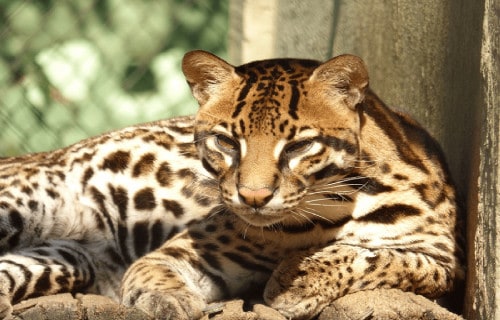
We sincerely hope that you enjoy this article about 5 Marvelous Mammals of Central America. This area of the world remains well known for teeming with life of all kinds, and mammals are no exception. Obviously, though, these few represent only the smallest percentage of the species to be found here. But, we hope that these 5 Marvelous Mammals of Central America serve to whet your appetite for discovering more.
Jaguarundi
Jaguarundi Facts
- Leading off this article about 5 Marvelous Mammals of Central America is the amazing animal known as the Jaguarundi.
- The term perfectly serves as the attention-grabbing common name for a truly remarkable species of wild cat. The scientific name of the mammal, however, remains that of the difficult to pronounce Herpailurus yagouaroundi.
- By either name, it represents an animal that, sadly, now only shows scattered population groupings. Thus, it remains vulnerable for several reasons. Officials generally fear that these pockets of habitation, most unfortunately, seem to be dying out.
- As a result, the Jaguarundi now represents a protected species throughout the majority of its native range. But, hunting does not pose its greatest threat. Loss of much of its traditional habitat serves as the principal threat to the existence of this mammal.
- In addition, the Amazon Basin currently forms the only region of its range in which the numbers of the awesome Jaguarundi appear to be stable. However, despite its situation, the IUCN currently lists the mammal as Least Concern.
- This surprising status appears on the organization’s Red List of Threatened Species. Nonetheless, many people currently believe it to be threatened. Most likely, at the present time, its greatest threats come from habitat loss and climate change.
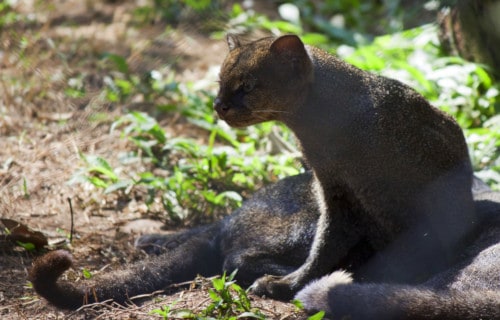
CCL: http://bit.ly/2xQPH8p
Jaguarundi Physical Description
Firstly, mature adult specimens of the Jaguarundi averages roughly 30 in (77 cm) in body length. Secondly, the tail also reaches a relatively great length of about 24 in (60 cm) in length. Further, adults sometimes weigh as much as 20 lb (9.1 kg).
This amazing species displays no noticeable degree of the physiological trait of sexual dimorphism. This extends to both appearance and physical size. Yet the wild feline does display one unique trait. This holds true due to the fact that it has a unique coloring.
That’s because the fur of different individuals sometimes appears as either a dark chestnut or brownish-black in color. But, quite surprisingly, there seems to be no genetic tendency for this, since individuals of either or both patterns may be born in the same litter.
In addition, the truly amazing Jaguarundi remains known among those who appreciate the wild cats for its distinctively short legs. In sharp contrast to this characteristic, the body of the remarkable mammal develops as quite elongated.
- Kingdom: Animalia
- Phylum: Chordata
- Class: Mammalia
- Order: Carnivora
- Family: Felidae
- Genus: Herpailurus
- Species: H. yagouaroundi
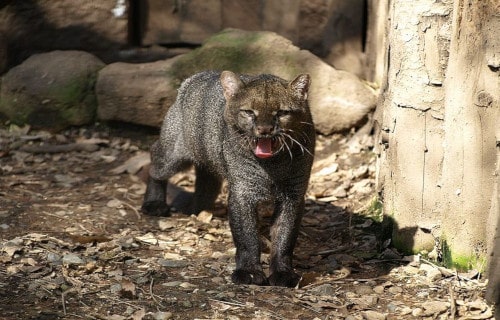
CCL: http://bit.ly/2IjEG4n
Jaguarundi Distribution, Habitat, and Ecology
To the surprise of some people, the amazing Jaguarundi represents a small species of wildcat primarily endemic to a moderately broad section of the world. More precisely, this mainly consists of specific regions of South America and Central America.
But, scattered small populations of this animal also exist as far north as the states of Texas and Florida, in North America. Furthermore, wherever individuals appear, this incredible wild feline has very specific requirements for its choice of habitat.
This holds true since most individuals prefer to inhabit low-lying areas of the brush. But, these must also be in close proximity to streams or small rivers. Although this limits its areas of habitation, it does include habitats ranging from wet grasslands to dry forests.
Human encroachment forced the Jaguarundi to adapt, however. Some also live in dense tropical regions, and at altitudes as high as 10,500 ft (3,200 m). Despite the intense activity, some have even been spotted in the vicinity of the Guiana Space Center, in French Guiana.
Honduran White Bat
Honduran White Bat Facts
- Next up among these choices for inclusion in this listing of 5 Marvelous Mammals of Central America is the awesome Honduran White Bat.
- First of all, the informative term perfectly serves as one of the common names of a highly unique species of bat. The other, somewhat longer, accepted common name for this astonishing species is the Caribbean white tent-making bat.
- However, Ectophylla alba serves as the shorter, more pronounceable scientific name for the species. But, regardless of which name one uses to refer to the fabulous animal, this remains one of the most highly distinctive varieties of bat.
- Furthermore, this particular natural distinctiveness occurs due to its unusual coloring. Despite centuries of exploration, few such creatures are known to exist. In point of fact, experts currently know of only six varieties of white bat in existence.
- More than 1,300 species of bat exist throughout the world. Therefore, less than 0.5% of related creatures display this color pattern. In addition, it also stands out for yet another reason. It’s among the few types that modifies its environment for its use.
- In addition, a sad fact about the known population of the magnificent Honduran White Bat exists. Most unfortunately, this now appears to be diminishing rapidly. As a result, the IUCN now lists the fascinating animal as Near-Threatened.
- Further, this very lamentable status appears on the organization’s Red List of Threatened Species. It appears there due to its current situation. Quite sadly, the highly remarkable small mammal currently faces several threats to its continued existence.
- Finally, one of these pressing dangers continues to be the numerous human incursions into its natural habitat. However, the greatest threat to the continued existence of this remarkable species comes from ongoing climate change.
Honduran White Bat Physical Description
The Honduran White Bat easily qualifies as remarkable. But it does not earn that adjective due to its size. It actually ranks as a small bat. In fact, mature adults attain an average body length of around 2 in (5 cm). Its weight typically averages only about 0.2 oz (6 grams).
But, its other physical traits merit attention. While its fur develops as short, it’s also typically a bright white in color. Various shades of light gray do occasionally manifest themselves. Also, the nose is relatively over-sized, and the ears and nose show a bright amber in color.
The Honduran White Bat also displays another appealing color pattern. Portions of the legs appear amber in color. Males and females also remain of roughly equal size, with no apparent sexual dimorphism. Finally, in stark contrast to its fur, the wings are completely black in color.
- Kingdom: Animalia
- Phylum: Chordata
- Class: Mammalia
- Order: Chiroptera
- Family: Phyllostomidae
- Genus: Ectophylla
- Species: E. alba
Honduran White Bat Distribution, Habitat, and Ecology
Most notably, the magnificent Honduran White Bat only inhabits a highly limited range of the world. Parts of this area also qualify as difficult to access. In point of fact, the animal appears endemically only in quite specific sections of the lowland rainforest.
This unique animal evolved as endemic to what now constitutes the four distinct countries of Costa Rica, Nicaragua, Honduras, and parts of Panama. The sole apparent reason for the specific nature of its habitat is the presence of the Heliconia plant.
Indeed, the surprisingly impressive species evolved a truly remarkable association with this one variety of flora. This relationship remains so strong that, within its natural environment, this typically constitutes the only location individuals will choose for shelter.
The reason remains understandable, though. This statement holds true since the large leaves of the plant form a perfect shelter for the Honduran White Bat. Furthermore, individuals will also cut along the veins of the leaves, forcing them to collapse inward.
This forms a V-shaped structure that the bats find convenient to use to roost. A single leaf may be home to 1-12 bats. This affords the mammal protection from both the heat of the sun and potential predators. Finally, this species also feeds as frugivorous in nature.
Ocelot
Ocelot Facts
- The third spot on this list of 5 Marvelous Mammals of Central America belongs to the gorgeous Ocelot, but only due to random selection.
- Perhaps most notably, the short term serves as the generally accepted common name of a truly stunning species of wildcat. However, despite its size, its scientific name aptly points out its relationship with larger felines.
- That holds true due to the fact that this name remains the impressive, though difficult to pronounce, term of the Leopardus pardalis. Further, the renowned Swedish zoologist Carl Linnaeus became the first person to officially describe the species, in 1758.
- Quite sadly, in the past, mankind widely hunted the animal for its pelt, which was regarded as highly valuable. Thankfully, due to a more enlightened government, this practice was banned decades ago throughout its endemic territory.
- Quite fortunately, while most wildcats see their numbers dwindling rapidly, the beautiful Ocelot stands apart. That’s because it holds the distinction of being one of the few wild felines that the IUCN lists as a Species of Least Concern.
- Previously, it held the status of Endangered, until the year 1996. But, thankfully, efforts at protecting the creature allowed its numbers to bounce back significantly. Nonetheless, it now faces the potential threat posed by ongoing climate change.
Ocelot Physical Description
First of all, the remarkable Ocelot earns its attention for reasons other than sheer size. To be more precise, the beautiful feline qualifies as a moderate-sized variety of wildcat. Further, the species also displays a moderate degree of sexual dimorphism.
Females of the species often weigh as much as 25 lb (11.3 kg). Meanwhile, the males reach a greater weight of as much as 34 lb (15 .5 kg). In addition, both sexes this beautiful mammal attains an average overall body length of between 22 – 39 in (55 – 100 cm).
That makes the magnificent species significantly smaller in size than most, but not all, wildcats. However, the moderately impressive tail adds an additional 10 – 16 in (25.5 – 41 cm) to the total length of the feline. It also serves to add to its beauty.
In color, the fur of the gorgeous Ocelot displays predominantly a tawny yellow with numerous black markings. Additionally, the neck and belly typically display a white coloring. Meanwhile, its fur usually remains short on the belly but grows longer on the back.
But, its distinctiveness does not end there. Adding to its visual appeal, the small ears usually remain rounded. These also display a prominent white spot, creating a dramatic effect. Also, the eyes most commonly show a brown color that reflects patterns of gold in bright light.
- Kingdom: Animalia
- Phylum: Chordata
- Class: Mammalia
- Order: Carnivora
- Family: Felidae
- Genus: Leopardus
- Species: L. paradis
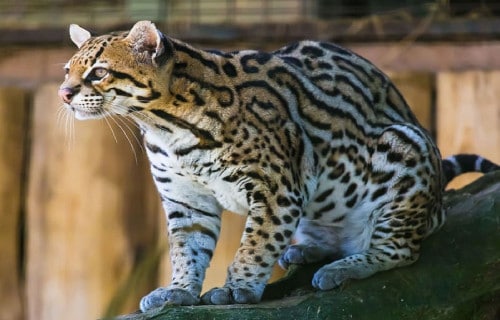
CCL: https://bit.ly/1ryPA8o
Ocelot Distribution, Habitat, and Ecology
Most notably, the actual range of the amazing Ocelot covers an extensive region of the globe. More precisely, this zone of habitation extends through portions of the United States, in North America, through Mexico and much of Central America and South America.
But, population densities for the creature also vary somewhat widely throughout its range. However, the highest known density occurring in Panama. In all areas, though, this particular animal inhabits an impressively wide range of habitats.
This flexibility contributed to its numbers rebounding from a few decades ago. These habitat types include such regions as rainforests, scrublands, mangrove forests, and even coastal marshes. It prefers lower elevations, but some occur as high as 9,843 ft (3,000 m).
Like all wildcats, the breathtaking Ocelot also evolved to have an entirely carnivorous diet. Given its habitat range, and its size, its primary prey consists of smaller creatures. Thankfully, however, its native range continues to have an abundance of these.
These include such species as rabbits, rodents, fish, birds, opossums, armadillos, and occasionally small reptiles and even insects. Finally, hunting typically occurs during the evening and at night, but sometimes happens during the day when necessary.
Capuchin
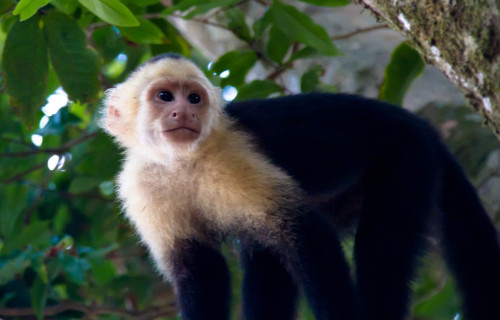
CCL: https://bit.ly/2PKLAVU
Capuchin Facts
- Our next selection to place in this compendium of 5 Marvelous Mammals of Central America is the well known Capuchin.
- First of all, the animal remains a quite remarkable, though somewhat small, species of New World monkey. Further, there remain only two known groups of Capuchin monkey. However, both live throughout a moderately large area.
- Also, the name of the awesome animal originates with the supposed resemblance to a specific group of humans. This group consists of members of the Order of Friars Minor Capuchin. Exactly when this occurred though, remains undetermined.
- But, the amazing Capuchin also has a singularly outstanding trait. That’s its intellectual capacity. That holds true due to the fact that this remarkable creature represents the most intelligent of all known New World simian species.
- Quite lamentably, this distinctive characteristic has also led to some extremely unsettling complications. Because of its intellect, this impressive creature has now become extremely common in laboratory research. That’s a practice we frown upon.
Capuchin Physical Description
Most notably, the highly fascinating Capuchin does not display any marked degree of the physiological characteristic of sexual dimorphism. This physical trait remains one the diminutive mammal shares with the vast majority of known simian varieties.
Quite understandably, the coloring of the individual varies slightly. That’s natural, given the number of different species. Typically, however, the color combinations include various shades of black, brown, and off-white. This makes for a striking appearance.
Additionally, mature adult specimens average roughly 22 in (56 cm) in body length. Meanwhile, average weights between the different species ranges significantly, from 3 – 9 lbs (1.36 – 4.1 kg). Also, the tails usually grow to about the same length as the body.
- Kingdom: Animalia
- Phylum: Chordata
- Class: Mammalia
- Order: Primates
- Family: Cebidae
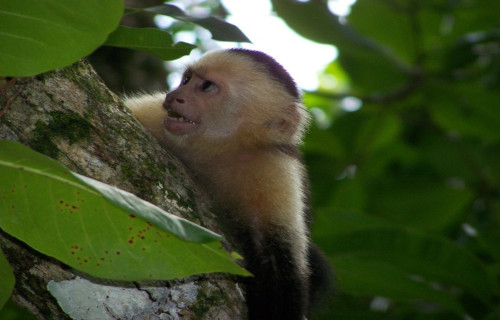
CCL: http://bit.ly/2P4R3Ic
Capuchin Distribution, Habitat, and Ecology
Firstly, the amazing Capuchin evolved to inhabit a comparatively wide zone of habitation. That is, at least when compared to many related species. This comparatively extensive range includes much of both Central America and South America.
Additionally, the remarkable animal has also proven to be quite adaptable. As a result, individuals can be found living in several different types of habitats. These habitat types typically include both wet lowland forests and dry deciduous forests.
Several species stand out to scientist. These have demonstrated an independently learned behavior, frequently to the surprise of researchers. That’s because this ability remains indicative of both high level observational skills and intelligent reasoning.
For example, during the mosquito season, individuals will crush millipedes and spread the remains on each other’s backs. This covering acts as a natural insect repellent. This behavior quite easily sets it apart from most related creatures.
As with most similar primates, this mammal evolved as both diurnal and arboreal in nature. It tends to spend the majority of the day foraging for its food. The Capuchin feeds omnivorously and consumes fruit, nuts, insects, spiders, eggs, and small invertebrates.
Further, this impressive monkey typically lives in large groups. These typically range in size from 10-40 individuals. In the wild, it usually lives 15-25 years. Finally, the primary predators of this animal include cougars, jaguars, and large snakes.
Margay
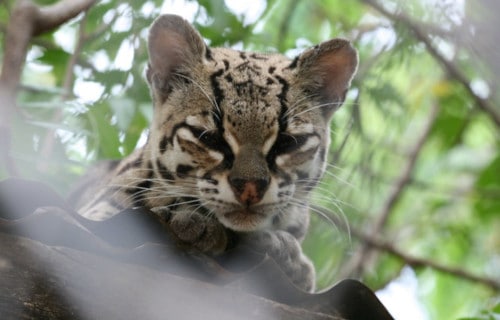
CCL: https://bit.ly/1jxQJMa
Margay Facts
- The fifth and final entry into this compilation of 5 Marvelous Mammals of Central America is the gorgeous feline called the Margay.
- Most notably, the short term quite easily serves as the generally accepted common name of a truly stunning species of wildcat. However, it also goes by the hard to pronounce scientific name of the Leopardus wiedii.
- But, regardless of the name one uses to refer to it, the creature remains an impressive animal, for many reasons. To begin with, this remarkable feline also remains a predominantly nocturnal animal within most of its territory.
- The species also typically prefers to spend the majority of its time in extremely remote sections within its native range. As a result this stunning marvel of Nature remains rarely seen by casual visitors to the region in which it appears.
- Currently, the IUCN lists the marvelous Margay as Near Threatened. Sadly, this unfortunate evaluation of its situation holds true throughout the entirety of its natural range. This status is reflected on the organization’s Red List of Threatened Species.
- Further, the highly lamentable situation the beautiful small wildcat finds itself in occurs due to several factors. Firstly, in some regions, people still slaughter an average of 14,000 of these beautiful wildcats annually for the fur.
- Quite understandably, this action has resulted in an extreme decrease in its population base. In addition, the twin perils of habitat loss and climate change continue to present extreme challenges to the reclusive small mammal.
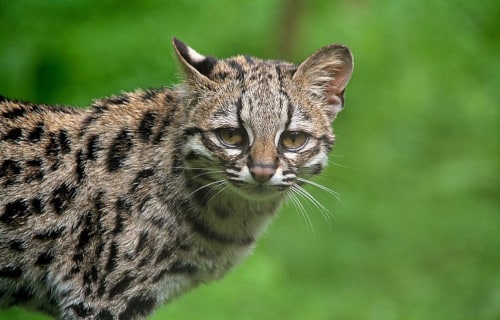
CCL: http://bit.ly/2IjEG4n
Margay Physical Description
Firstly, although it certainly qualifies as an impressive animal, the Margay does not attain this status due to physical size. That’s because the feline only attains a small size in terms of sheer mass. In fact, it reaches a maximum known weight of as much as 8.8 lb (4 kg).
Furthermore, the body length of mature adult specimens averages about 31 in (79 cm). Meanwhile, the tail, somewhat surprisingly, grows to a length equal to a significant percentage of the length of the body. This generally measures 20 in (51 cm) in length.
Its fur also displays a distinctive pattern. This consists of a light brown that appears splotched with dark brown or black blotches and streaks. In the meantime, the stomach of this creature generally displays an off-white, and the tail has multiple bands, with a black tip.
Perhaps the most distinctive feature of the Margay remains the fact that it has a remarkable evolutionary adaptation in its ankles. These evolved to be so flexible that the cats can actually walk down a tree trunk headfirst. It’s one of only two known to possess this ability.
- Kingdom: Animalia
- Phylum: Chordata
- Class: Mammalia
- Order: Carnivora
- Family: Felidae
- Genus: Leopardus
- Species: L. wiedii
Margay Distribution, Habitat, and Ecology
Quite unfortunately, the gorgeous animal known as the Margay only inhabits a relatively small section of the world. This holds true because of the fact that it only appears in a limited area composed of sections of North America, Central America, and South America.
However, evidence also indicates that this beautiful creature once ranged as far north as the states of Georgia and Florida, in the United States. In addition, even within this range of habitation, the creature has very specific preferences for its choice of habitat.
That’s true, first, since this truly amazing wildcat lives almost exclusively in areas of dense forest. Second, though, this includes such typical habitats as the numerous prominent tropical dry forests, evergreen forests, and cloud forests, sometimes known as fog forest.
Furthermore, the beautiful and truly remarkable Margay evolved to be principally arboreal in its base nature. In point of fact, and incredibly, the great majority of individuals often spend their entire lives within the canopy, never coming down.
Finally, the wildcat will also occasionally establish its territory in a hard to believe location. To the amazement of many people, this consists of commercial plantations. Unfortunately, this only further increases its vulnerability to hunting.

CCL: http://bit.ly/2IjEG4n
5 Marvelous Mammals of Central America
We sincerely hope that you have greatly enjoyed this article about 5 Marvelous Mammals of Central America. This region boasts an incredible array of both fauna and flora to please the eye. But, many of these species now find themselves in great peril. It remains up to each of us to do all that we can to protect and preserve them for our posterity.
Check out our other articles on Earth’s Many Magnificent Marsupials, 7 Spectacular Geological Marvels of Europe, Sensational Spiders Around the World
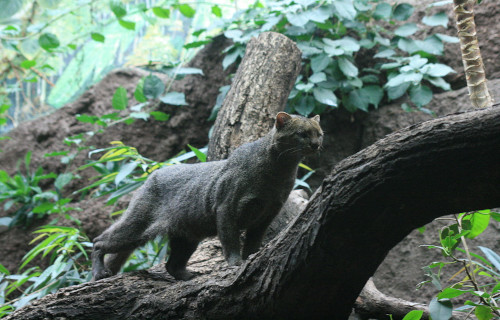
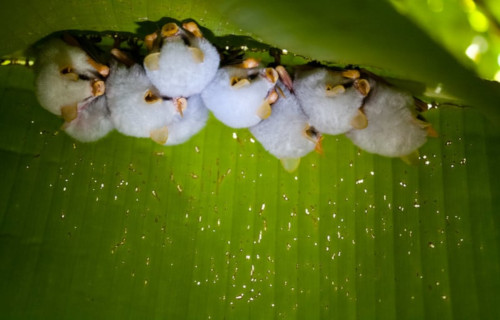

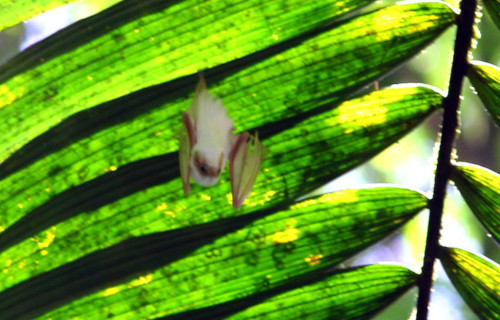
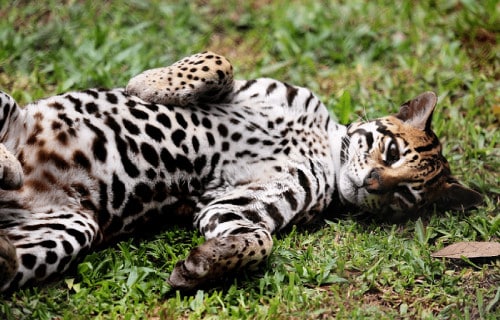
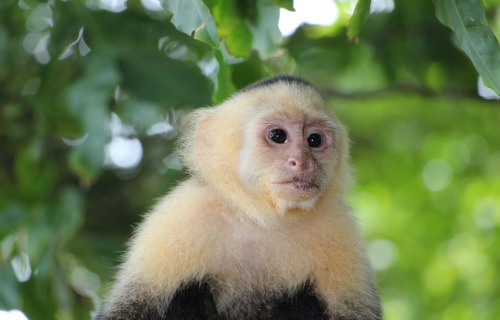
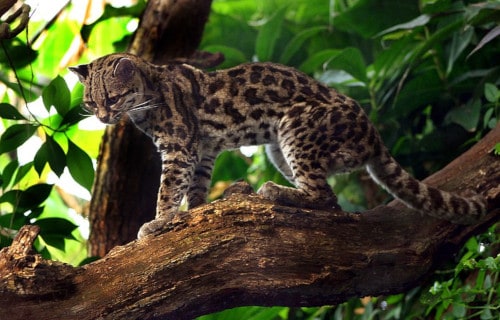









Leave a Reply